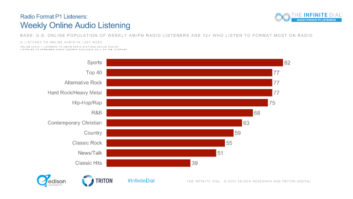The Infinite Stream
Aug 1, 2005 12:00 PM, By Gary Eskow
The Internet has been easy to embrace, and obviously helpful in many ways. But how do Google searches and Itunes translate into advertising revenue? What are the business models?
Infinity, one of the largest radio broadcasters in the country, avoided streaming for years; now it’s in the fold. Why? Are there lessons in Infinity’s migration to the Internet that others can draw lessons from? Matt Timothy, Infinity’s vice president of streaming media provides some answers about these issues.
“Why is Inifinity, which has avoided streaming for so long, embracing it now? I don’t know the answer, other than to say, why not now?” asks Timothy. “We have a tremendous collection of local brands, and Infinity wants to unlock that value, to extend it to platforms and places where everyone can access it.

Web tuners, like this one for Infinity’s WINS, provide more visual information than radio has previously been able to provide.
“Attracting advertisers targeting localized markets is one strong advantage of streaming broadcasts,” said Timothy. “Advertisers are on board, without a doubt. Our initial streaming launch consisted of 12 news stations, and the response from advertisers has been great. Fundamentally, streaming allows us to expand the sales conversations we have with potential advertisers in two ways: we can talk to individuals and companies who haven’t been able to afford our services in the past, and we can now offer them a suite of tools that were not available in the past. For example, banners and online spots give advertisers more choices, and more entry points into the markets we provide them with.”
When asked if streaming helps Infinity compete with satellite radio, Timothy says, “Let’s say that it allows our brands to be heard in more places. Reaching people while they are at work is important, and streaming gives us more shelf space for our brands. We have an aggressive, nimble sales force on the ground, and streaming gives them even more to sell.”
Negotiating with AFTRA and other talent unions has been a sticking point for many would-be advertisers on a budget. What is Infinity’s position on this ticklish issue? “In any new initiative there are obstacles and challenges to overcome. The potential for this business is big enough that we’re addressing the issue you just brought up every single day.”
Yes, but there must be a way to provide one layer of spot production for entry level clients, and another that uses top union talent, for national clients with larger budgets, right? “We can accommodate Home Depot, for example, and its desire to appear on our sites, as well as the most local, community based businesses. The conversation we have with talent unions and others is on-going. The cement is still wet on the policies we’re developing in this area.”
Technology approach
Ray Miklius, vice president of studio systems for Broadcast Electronics, said that his company has expanded into datacasting products and services. For example, BE provides Sonixtream, an application to allow Internet listeners see the title of a song and information on the artist. The system also provides real-time data for other playback devices, including car radios and table-top units.
“After the Internet advertising crash of 2001, companies realized that the level of advertising they received from streaming couldn’t support the initiatives that had been undertaken on the Internet, in part because the valuations coming from Internet companies were inflated. Royalty uncertainty was also an issue, and radio seemed ready to disappear from the Internet, from a streaming standpoint,” said Miklius.
“The CARP and AFTRA negotiations didn’t make things easier for clients. AFTRA, for example, wanted a lot more money for a spot played on the Internet than via terrestrial broadcast, but that just didn’t make sense for advertisers. A major push to replace ads came to be. Stations needed to get the union spots off the Internet because they could not afford them.”
Miklius added, “To be fair, an important point was reached when customers realized that local transmission at affordable rates brought additional assets into the picture. At that point, new models for monetizing the Internet stream came into being that were more focused, and in some cases, targeted to a quite specific market.
“Everyone’s looking for revenue growth, and streaming is definitely more economical than it was four years ago. Bandwidth rates, for example, have dropped significantly. It’s great for a listener to have a DSL line for $40 a month, but when you need lots of bandwidth price becomes an important factor. Not long ago a megabyte of bandwidth cost about $500 a month. The price has dropped significantly. And now that the fiber has been laid and the infrastructure is in place, rates have dropped by a factor of 10 to 1 over the last three years,” said Miklius.
“Traditional radio streams will continue to be viable for many years with Internet streaming simply adding value for advertisers,” said Miklius. “Graphics, for example, are obviously not possible with radio, but they can be incorporated into streaming audio in a number of creative ways that will help listeners remember information. Album artwork can be displayed while a song is playing. The Web address of an advertiser, a coupon code or a number of other pieces of information can be displayed as well. A new level of interactivity has been added for the listener. Stations have to sell the value to their advertising base. That’s how these services will get properly monetized.”
Additional interactivity allows listeners to purchase music online. Likewise, a listener can click to an advertiser’s website if he hears something he likes.
Clearly, the day has arrived when creative ways to use the Internet will result in effective new revenue streams for advertisers at all entry points. Taking this message to mom and pop stores and all the way up to the most visible national advertisers is the next important step for broadcasters looking to profit from Internet streaming.
Eskow is a freelance technology writer in New Jersey, and contributing editor to Radio magazine’s sister publication Mix magazine.












